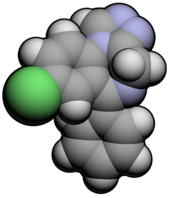Chemistry:Estazolam
 | |
 | |
| Clinical data | |
|---|---|
| Trade names | Prosom, Esilgan, Eurodin, Nuctalon, others |
| Other names | Desmethylalprazolam |
| AHFS/Drugs.com | Monograph |
| MedlinePlus | a691003 |
| License data | |
| Pregnancy category |
|
| Routes of administration | By mouth |
| ATC code | |
| Legal status | |
| Legal status |
|
| Pharmacokinetic data | |
| Bioavailability | 93% |
| Metabolism | Liver |
| Elimination half-life | 10–24 hours |
| Excretion | Kidney |
| Identifiers | |
| |
| CAS Number | |
| PubChem CID | |
| IUPHAR/BPS | |
| DrugBank | |
| ChemSpider | |
| UNII | |
| KEGG | |
| ChEBI | |
| ChEMBL | |
| Chemical and physical data | |
| Formula | C16H11ClN4 |
| Molar mass | 294.74 g·mol−1 |
| 3D model (JSmol) | |
| |
| |
| (verify) | |
Estazolam, sold under the brand name Prosom among others, is a tranquilizer medication of the triazolobenzodiazepine (TBZD) class, which are benzodiazepines (BZDs) fused with a triazole ring. It possesses anxiolytic, anticonvulsant, hypnotic, sedative and skeletal muscle relaxant properties. Estazolam is an intermediate-acting oral benzodiazepine. It is used for short-term treatment of insomnia.
It was patented in 1968 and came into medical use in 1975.[3]
Medical uses


Estazolam is prescribed for the short-term treatment of certain sleep disorders. It is an effective hypnotic drug showing efficacy in increasing the time spent asleep as well as reducing awakenings during the night. Combination with non-pharmacological options for sleep management results in long-term improvements in sleep quality after discontinuation of short-term estazolam therapy.[4][5] Estazolam is also sometimes used as a preoperative sleep aid. It was found to be superior to triazolam in side effect profile in preoperative patients in a trial.[6] Estazolam also has anxiolytic properties and due to its long half life can be an effective short-term treatment for insomnia associated with anxiety.[7]
Side effects
A hang-over effect commonly occurs with next day impairments of mental and physical performance.[8] Other side effects of estazolam include somnolence, dizziness, hypokinesia, and abnormal coordination.[9]
In September 2020, the U.S. Food and Drug Administration (FDA) required the boxed warning be updated for all benzodiazepine medicines to describe the risks of abuse, misuse, addiction, physical dependence, and withdrawal reactions consistently across all the medicines in the class.[10]
Tolerance and dependence
The main safety concern of benzodiazepines such as estazolam is a benzodiazepine dependence and the subsequent benzodiazepine withdrawal syndrome which can occur upon discontinuation of the estazolam. A review of the literature found that long-term use of benzodiazepines such as estazolam is associated with drug tolerance, drug dependence, rebound insomnia and CNS related adverse effects. Estazolam should only be used short term and at the lowest effective dose to avoid complications related to long-term use. Non-pharmacological treatment options however, were found to have sustained improvements in sleep quality.[11][12] The short-term benefits of benzodiazepines on sleep begin to reduce after a few days due to tolerance to the hypnotic effects of benzodiazepines in the elderly.[13]
Contraindications and special caution
Benzodiazepines require special precaution if used in the elderly, during pregnancy, in children, alcohol or drug-dependent individuals and individuals with comorbid psychiatric disorders.[14]
Pharmacology
Estazolam is classed as a "triazolo" benzodiazepine drug.[15] Estazolam exerts its therapeutic effects via its benzodiazepines receptor agonist properties.[16] Estazolam at high doses decreases histamine turnover via its action at the benzodiazepine-GABA receptor complex in mouse brains.[17]
Pharmacokinetics
Peak plasma levels are achieved within 1–6 hours. Estazolam is an intermediate acting benzodiazepine. The elimination half life of estazolam is an average of 19 hours, with a range of 8–31 hours.[18][19] The major metabolite of estazolam is 4-hydroxyestazolam.[20] Other identified metabolites include 1-oxo-estazolam, 4'-hydroxy-estazolam, and benzophenone.[2]
Interactions
Alcohol enhances the sedative hypnotic properties of estazolam.[21] In package inserts, the manufacturer clearly warns about an interaction with Ritonavir, and although clinical interactions of Ritonavir with estazolam have not yet been described, the lack of clinical descriptions of the interactions does not negate the seriousness of the interaction.[22]
EEG effects in rabbits
An animal study in rabbits demonstrated that estazolam induces a drowsy pattern of spontaneous EEG including high voltage slow waves and spindle bursts increase in the cortex and amygdala, while the hippocampal theta rhythm is desynchronized. Also low voltage fast waves occur particularly in the cortical EEG. The EEG arousal response to auditory stimulation and to electric stimulation of the mesencephalic reticular formation, posterior hypothalamus and centromedian thalamus is significantly suppressed. The photic driving response elicited by a flash light in the visual cortex is significantly suppressed by estazolam.[23]
Abuse
A primate study found that estazolam has abuse potential.[24] Two types of drug misuse can occur; recreational misuse, where the drug is taken to achieve a high or when the drug is continued long term against medical advice.[25] Estazolam became notorious in 1998 when a large amount of an 'herbal sleeping mix' called Sleeping Buddha was recalled from the shelves after the FDA discovered that it contained estazolam.[26] In 2007, a Canadian product called Sleepees was recalled after it was found to contain undeclared estazolam.[27][28]
See also
- Alprazolam
- Benzodiazepine
- Benzodiazepine dependence
- Benzodiazepine withdrawal syndrome
- Long-term effects of benzodiazepines
- Brotizolam
- Midazolam
- Triazolam
References
- ↑ "Estazolam (Prosom) Use During Pregnancy". 18 September 2020. https://www.drugs.com/pregnancy/estazolam.html.
- ↑ 2.0 2.1 "Estazolam tablet". 30 September 2020. https://dailymed.nlm.nih.gov/dailymed/drugInfo.cfm?setid=a1e3b4bf-22e9-430a-a768-4d86ae886c9e.
- ↑ (in en) Analogue-based Drug Discovery. John Wiley & Sons. 2006. p. 538. ISBN 9783527607495. https://books.google.com/books?id=FjKfqkaKkAAC&pg=PA538.
- ↑ "Dose-related effects of estazolam on sleep of patients with insomnia". Journal of Clinical Psychopharmacology 3 (3): 152–156. June 1983. doi:10.1097/00004714-198306000-00002. PMID 6135720.
- ↑ "Psychophysiological insomnia: combined effects of pharmacotherapy and relaxation-based treatments". Sleep Medicine 1 (4): 279–288. October 2000. doi:10.1016/S1389-9457(00)00042-3. PMID 11040460.
- ↑ "[Controlled clinical evaluation of 2 hypnotic triazole benzodiazepines, estazolam and triazolam, used the night before surgical interventions]" (in it). Minerva Medica 78 (18): 1381–1384. September 1987. PMID 2889169.
- ↑ "Estazolam treatment of insomnia in generalized anxiety disorder: a placebo-controlled study". Journal of Clinical Psychopharmacology 11 (4): 249–253. August 1991. doi:10.1097/00004714-199108000-00005. PMID 1918423.
- ↑ "[Alterations of sleep stage pattern in human beings and hang-over effects under the influence of estazolam/2nd Comm.: Studies on the hang-over effect in psycho-physiological performance (author's transl)]" (in de). Arzneimittel-Forschung 32 (4): 456–460. 1982. PMID 6125155.
- ↑ "Safety of estazolam. The United States clinical experience". The American Journal of Medicine 88 (3A): 12S-17S. March 1990. doi:10.1016/0002-9343(90)90280-Q. PMID 1968713.
- ↑ "FDA expands Boxed Warning to improve safe use of benzodiazepine drug". 23 September 2020. https://www.fda.gov/drugs/drug-safety-and-availability/fda-requiring-boxed-warning-updated-improve-safe-use-benzodiazepine-drug-class.
 This article incorporates text from this source, which is in the public domain.
This article incorporates text from this source, which is in the public domain.
- ↑ "Management of insomnia". Journal of the American Pharmaceutical Association 39 (5): 688–96; quiz 713–4. 1999. doi:10.1016/S1086-5802(15)30354-5. PMID 10533351.
- ↑ "Overview of the therapeutic management of insomnia with zolpidem". CNS Drugs 18 (Suppl 1): 17–23; discussion 41, 43–5. 2004. doi:10.2165/00023210-200418001-00005. PMID 15291010.
- ↑ "Benzodiazepines for insomnia in community-dwelling elderly: a review of benefit and risk". The Journal of Family Practice 41 (5): 473–481. November 1995. PMID 7595266.
- ↑ "Benzodiazepine dependence: focus on withdrawal syndrome". Annales Pharmaceutiques Françaises 67 (6): 408–413. November 2009. doi:10.1016/j.pharma.2009.07.001. PMID 19900604.
- ↑ "Pharmacological characterization of benzodiazepine receptors in the brain". European Journal of Pharmacology 48 (3): 263–270. April 1978. doi:10.1016/0014-2999(78)90085-7. PMID 639854.
- ↑ "Design and synthesis of 4H-3-(2-phenoxy)phenyl-1,2,4-triazole derivatives as benzodiazepine receptor agonists". Bioorganic & Medicinal Chemistry 11 (5): 769–773. March 2003. doi:10.1016/S0968-0896(02)00469-8. PMID 12538007.
- ↑ "Diazepam-induced decrease in histamine turnover in mouse brain". European Journal of Pharmacology 124 (3): 337–342. May 1986. doi:10.1016/0014-2999(86)90236-0. PMID 3089825.
- ↑ "Single- and multiple-dose kinetics of estazolam, a triazolo benzodiazepine". Psychopharmacology 66 (3): 267–274. 1979. doi:10.1007/BF00428318. PMID 43552.
- ↑ "Kinetic and pharmacological studies on estazolam in mice and man". Xenobiotica; The Fate of Foreign Compounds in Biological Systems 15 (3): 257–265. March 1985. doi:10.3109/00498258509045357. PMID 2862746.
- ↑ "Identification of human cytochrome P450 enzymes involved in the formation of 4-hydroxyestazolam from estazolam". Xenobiotica; The Fate of Foreign Compounds in Biological Systems 35 (5): 455–465. May 2005. doi:10.1080/00498250500111612. PMID 16012077.
- ↑ "Pharmacokinetics and drug interactions of the sedative hypnotics". Psychopharmacology Bulletin 37 (1): 10–29. 2003. doi:10.1007/BF01990373. PMID 14561946. http://www.medworksmedia.com/psychopharmbulletin/pdf/12/010-029_PB%20W03_Wang_final.pdf.
- ↑ "Determination of estazolam in plasma by high-performance liquid chromatography with solid-phase extraction" (PDF). Analytical Sciences 18 (5): 525–528. May 2002. doi:10.2116/analsci.18.525. PMID 12036118.
- ↑ "[Electroencephalographic effects of 450191-S and its metabolites in rabbits with chronic electrode implants]". Nihon Yakurigaku Zasshi. Folia Pharmacologica Japonica 88 (1): 19–32. July 1986. doi:10.1254/fpj.88.19. PMID 3758874.
- ↑ "Benzodiazepine self-administration in rhesus monkeys: estazolam, flurazepam and lorazepam". Pharmacology, Biochemistry, and Behavior 26 (3): 521–526. March 1987. doi:10.1016/0091-3057(87)90159-6. PMID 2883668.
- ↑ "Relative abuse liability of hypnotic drugs: a conceptual framework and algorithm for differentiating among compounds". The Journal of Clinical Psychiatry 66 (Suppl 9): 31–41. 2005. PMID 16336040.
- ↑ Food and Drug Administration; U.S. Department of Health and Human Services (10 March 1998). "FDA WARNS CONSUMERS AGAINST TAKING DIETARY SUPPLEMENT "SLEEPING BUDDHA"". FDA. https://www.fda.gov/bbs/topics/NEWS/NEW00625.html.
- ↑ "Potentially habit-forming herbal sleep aid recalled". CBC News. Feb 23, 2007. https://www.cbc.ca/news/potentially-habit-forming-herbal-sleep-aid-recalled-1.682661.
- ↑ "Losing sleep over 'natural' aids". The Globe and Mail. Aug 14, 2007. https://www.theglobeandmail.com/life/losing-sleep-over-natural-aids/article1080274/.
External links
- "Estazolam". Drug Information Portal. U.S. National Library of Medicine. https://druginfo.nlm.nih.gov/drugportal/name/estazolam.
 |
